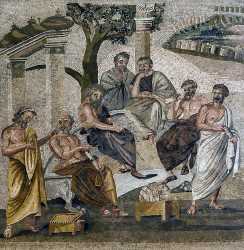Literacy goes back thousands of years, but the popularity of literacy in the world is a very new phase. Thanks to the Industrial Revolution, the cheapening of paper and printing, and the fact that books became more accessible. The graffiti and signs found on the walls of some old Roman cities such as Pompeii show that the people were literate enough to be guided by signs but still some favored road signs made into symbols such as in Ephesus.

For most non-elite free citizens, education began with the father. Children learned trades such as agriculture or crafts such as masonry or pottery from their fathers. In many parts of Anatolia, agriculture had always been seen as a family occupation and tradition to be passed to the next generation. School education compared to vocational-based family education appeared as a more social and city-wide organization in the Ancient Period.
Education was a luxury. In the Ancient World, children had to come from wealthy families to receive education such as reading, writing, and arithmetic. In ancient Anatolia, basic education was free for everyone coming from high-class families of the city, but you still had to pay to take courses in rhetoric and philosophy.
Citizens of the ancient cities such as Ephesus, Hierapolis, Pergamon, and many more attached great importance to education. Literacy became widespread thanks to the Greek alphabet, which reached an advanced level with the spread of education. Of course, only the Greek nobility could benefit from the educational service. The Greeks were influenced by the Phoenicians and developed the Greek alphabet. They added vowels to the consonant rich alphabet of the Phoenicians and formed the Greek alphabet. Latin also has the feature of being an alphabet derived from the Greek alphabet too.
The first evidence for the existence of primary schools is mentioned in the tales of Herodotus. The first vase paintings depicting school life belong to the fifth century BC. On the vase, all three courses that should be included in education are pictured: literature, music, and sports.
Books were often copied by the authors’ slaves and distributed by the authors. Books were generally circulated by the authors giving them to their relatives and acquaintances. The Greeks used a variety of materials for writing, from lead and wood to papyrus and parchment. The fact that papyrus is an expensive imported material has limited its use in daily life. Mostly wood-like mediums were used in schools and other daily works.
In the ancient world, librarianship started with the establishment of private libraries by tyrants and prominent political and cultural figures and reached its zenith with the libraries of Alexandria, Celsus Library of Ephesus, and Pergamon Library in the Hellenistic Period. These libraries did not only house books but also offices, study spaces, schools, etc. around them. Libraries of the ancient world functioned as cultural centers. Their directors were chosen from the leading writers, philosophers, and politicians of the period. As we know, public libraries actually became widespread during the Hellenistic Period.
Papyrus was a well-known product in these times, but it was very expensive to use. Papyrus was obtained by hand from the plant of the same name. The papyrus plant was mainly grown in the Nile delta of Ancient Egypt. Production was completely monopolized by the Egyptian Pharaohs. Besides being valuable, it is an extremely durable material when stored in a dry place. The famous physician Galen spoke about reading three centuries-old papyrus scrolls. Even the Pergamonites (People of Pergamon city) discovered parchment made from animal skin. Parchment was a harder and stronger material than Papyrus, but it was more difficult to write. As a matter of fact, it surpassed papyrus in later use.